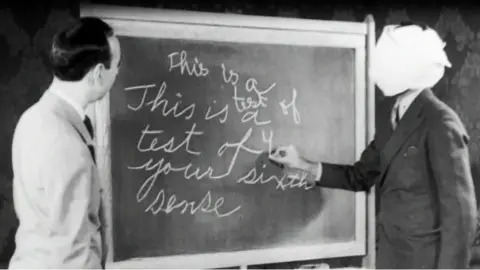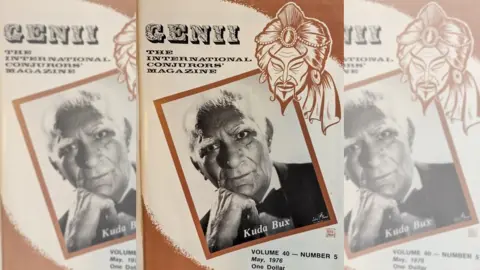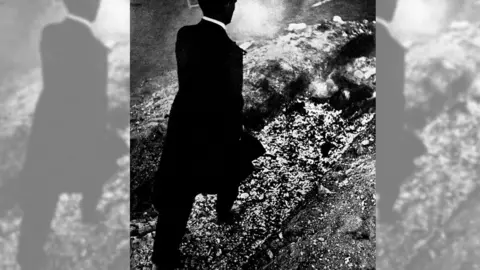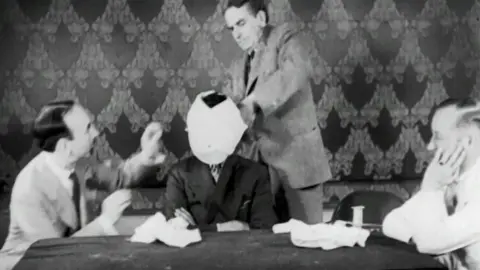Kuda Bux: The Indian magician who charmed the West with his 'X-ray eyes'
 Picture: British Pathé
Picture: British PathéThere's nothing spectacular about a man riding a bicycle through a crowded street.
But what if his eyes were covered with lumps of dough, thick swabs of cotton and several layers of gauze - and he had multiple layers of bandages wound tightly around his head in such a way that only his nostrils were left exposed?
Kuda Bux, who was born in Kashmir in 1905, was famous for performing this cycling feat on streets of England and Europe in the 1930s and 40s - something he claimed he was able to do because he could "see without eyes".
He headlined his magic shows "the man with X-ray eyes" and would appear to perform a mind-boggling range of activities - including reading passages from books and threading a needle - while covering his eyes in his signature style.
Bux has fascinated generations with his seemingly superhuman ability. He reportedly inspired Roald Dahl's 1977 short tale, The Wonderful Story of Henry Sugar, which has now been adapted into an eponymously-titled film by Wes Anderson.
Bux, whose original name was Khudah Bukhsh, was born in a wealthy family. In a 1952 interview with Dahl for Argosy Magazine, he spoke about being fascinated by magic after a performance by an Indian conjurer who went by the name of Professor Moor.
Two days later, he ran away from home and followed Moor to Lahore to work as his assistant at the age of 13. In the following years, he would travel through Burma (Myanmar), Ceylon (Sri Lanka) and Bombay (Mumbai), learning tricks and skills from traveling magicians, yogis and theatre artists.
He also changed his name to Professor KB Duke and then to Kuda Bux, author John Zubrzycki writes in his book Empire of Enchantment: The Story of Indian Magic.
 Caitlyn Renee Miller
Caitlyn Renee MillerIn May 1935, he sailed to England, where there was an appetite for magicians from the Eastern world.
"India was seen as 'the land of magic,' a perception that grew out of the writings of travellers, missionaries, merchants and historians, who visited India and wrote about their fascinating, but often embellished, encounters with street or court magicians," Mr Zubrzycki tells the BBC.
Many Indian magicians capitalised on the West's fascination with magical acts from overseas, and Bux was one of them. Even though he dressed like an Englishman, he would link his magical abilities to Eastern mysticism.
Writing about Bux in the magic magazine The Linking Ring, historian John Booth describes him as "that mysterious man from the Indian subcontinent who rode bicycles blindfolded in Paris" who had the "air of a mystic".
In England, Bux quickly rose to fame with what he called his X-ray vision act, attracting the attention of sceptics who subjected him to "tests" to check the authenticity of his abilities.
In July 1935, Harry Price - Britain's famous "ghost hunter" - and a team of doctors tested Bux's X-ray vision claims. "Price came prepared with surgical bandages, adhesive tape, pads of cotton wool and a special tie-on mask composed of two thicknesses of heavy black cotton between which was a layer of cotton wool," Mr Zubrzycki notes in his book.
After Bux successfully read from a book with the bandaging on, a doctor redid his blindfold. Bux was still able to read a handwritten note that was placed on a table behind his back.
In September 1935, Bux was put to another test, again by Price, and this ended up propelling him to fame in England and much of Europe.
In the Surrey countryside, Bux performed his fire-walking feat - the first time it was ever performed in England - in the presence of doctors, psychologists and journalists. The observers were charged with testing every aspect of the act, including Bux's feet before and after the walk, to spot any kind of trickery that might be at play.
 Getty Images
Getty ImagesA pit was dug and filled with logs of wood, charcoal, paraffin and newspapers that were set on fire. A couple of hours later, Bux walked across the glowing fire-pit not once, but four times. "There was not a suspicion of a blister" on his feet, Price noted in his book, Confessions of a Ghost-hunter.
Nine days later, and in the presence of more observers, Bux walked twice across a fire-pit hot enough to melt steel. But this time too Bux's feet remained unscathed, leading Price to hypothesise that "there was some obscure relationship between physical and mental forces that helps to make him immune from injury", Mr Zubrzycki writes.
In the interview with Dahl, Bux would claim that he survived fire-walks by "concentrating to such a degree that I see nothing but the fire, and the fire being cold".
He claimed that this "inner sense of sight" also helped him perform his "X-ray vision" feats and that he honed this sense by "concentrating the conscious mind" through exercises a yogi taught him when he was a teenager.
These involved staring at the black spot of a candle flame until "everything around him disappeared" and he could fully visualise the face of the person he loved the most - his brother.
After practising the candle exercise every night for years, Bux realised at the age of 24 that if he shut his eyes and concentrated fiercely on something, "I can see vaguely, dimly, the outline of the object I am looking at".
By the time he was 28, he could read a book blindfolded, he claimed.
 British Pathé
British PathéBux's claims didn't go unchallenged. Some who studied his so-called X-ray act concluded that he was peeking down the sides of his nose, says Caitlyn Renee Miller, who has written a paper on Bux. But that didn't interfere with his popularity.
Thousands flocked to watch his shows, while the press labelled him "the wonder of the century" and the "eighth wonder of the world", magician Bill Larsen notes in an article in magic magazine Genii.
Bux appeared on the first televised episode of Ripley's Believe It Or Not and even had his own TV show: Kuda Bux, Hindu Mystic.
So convincing was Bux's act that it made people believe that he could really "see without sight". Booth wrote about how one of Bux's claims, which was widely repeated by the press, led to trepidation among three female performers who were set to perform at one of Bux's shows.
Bux claimed that he had been practising to look through brick walls, which led to the women demanding dressing rooms far away from Bux.
"There is only one brick wall between us and Kuda Bux," they complained.
He eventually left London and moved to the US, where he would continue performing, including at the famous Magic Castle, a club in Hollywood.
Bux died in 1981 in Los Angeles, California. He spent his last days playing cards at the Magic Castle with magicians who - Booth notes - claimed they could beat Bux only if he didn't put on his blindfold.
BBC News India is now on YouTube. Click here to subscribe and watch our documentaries, explainers and features.

Read more India stories from the BBC:

